BSBRSK401: Identifying Risk & Applying Risk Management Processes
VerifiedAdded on 2023/04/20
|32
|9639
|155
Homework Assignment
AI Summary
This assignment provides a solution to the BSBRSK401 assessment guide, focusing on identifying risk and applying risk management processes. It addresses key questions related to the definition of risk management, contexts where risks need management in the workplace (health and safety, uncertainty-based, and opportunity-based risks), the importance of effective and planned risk management treatments, and various risk identification tools such as risk registers, probability and influence matrices, and the Delphi technique. The document also includes an assessment cover sheet, plagiarism guidelines, and copyright information, ensuring a comprehensive understanding of risk management principles and practices.
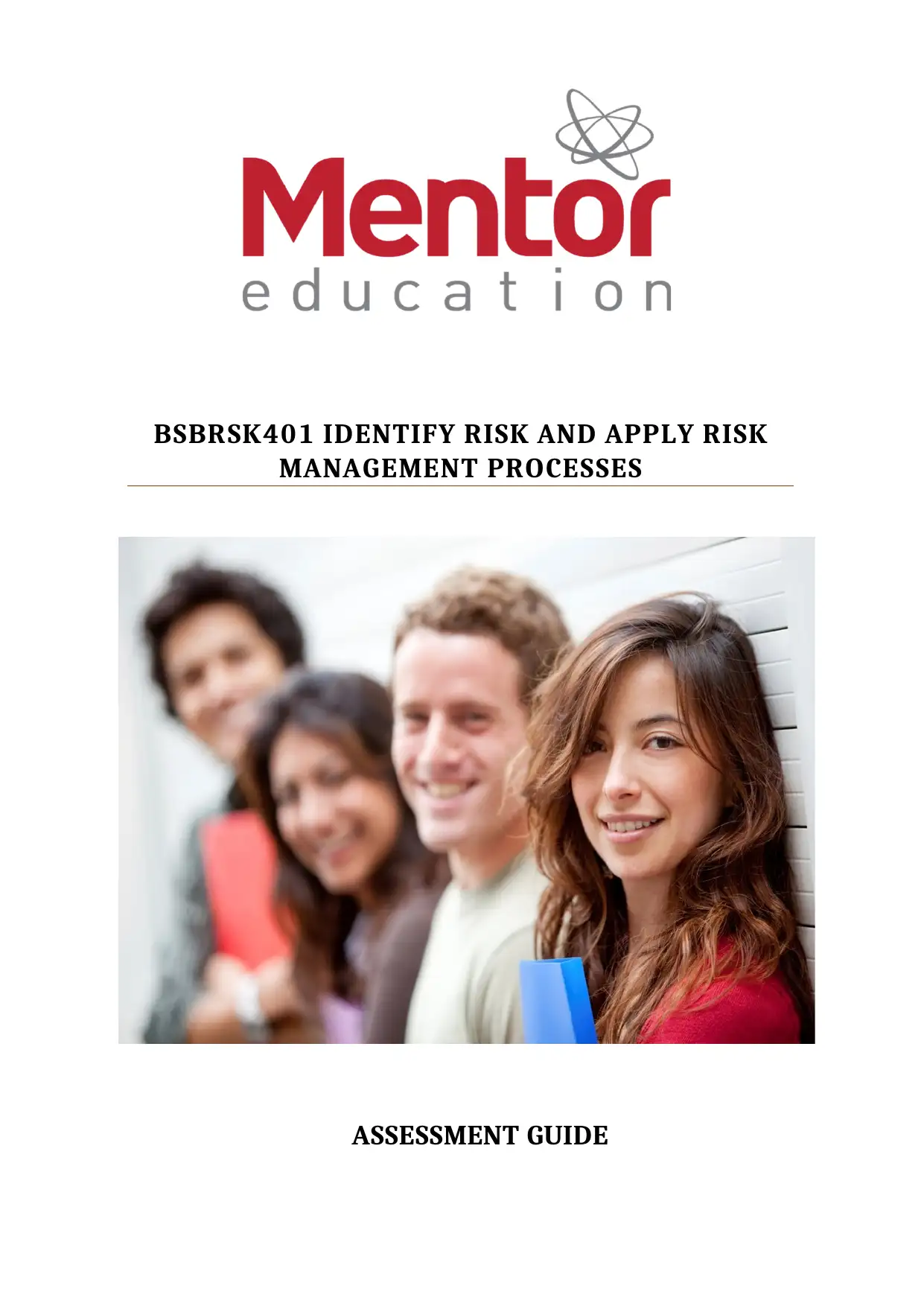
BSBRSK401 IDENTIFY RISK AND APPLY RISK
MANAGEMENT PROCESSES
ASSESSMENT GUIDE
MANAGEMENT PROCESSES
ASSESSMENT GUIDE
Paraphrase This Document
Need a fresh take? Get an instant paraphrase of this document with our AI Paraphraser
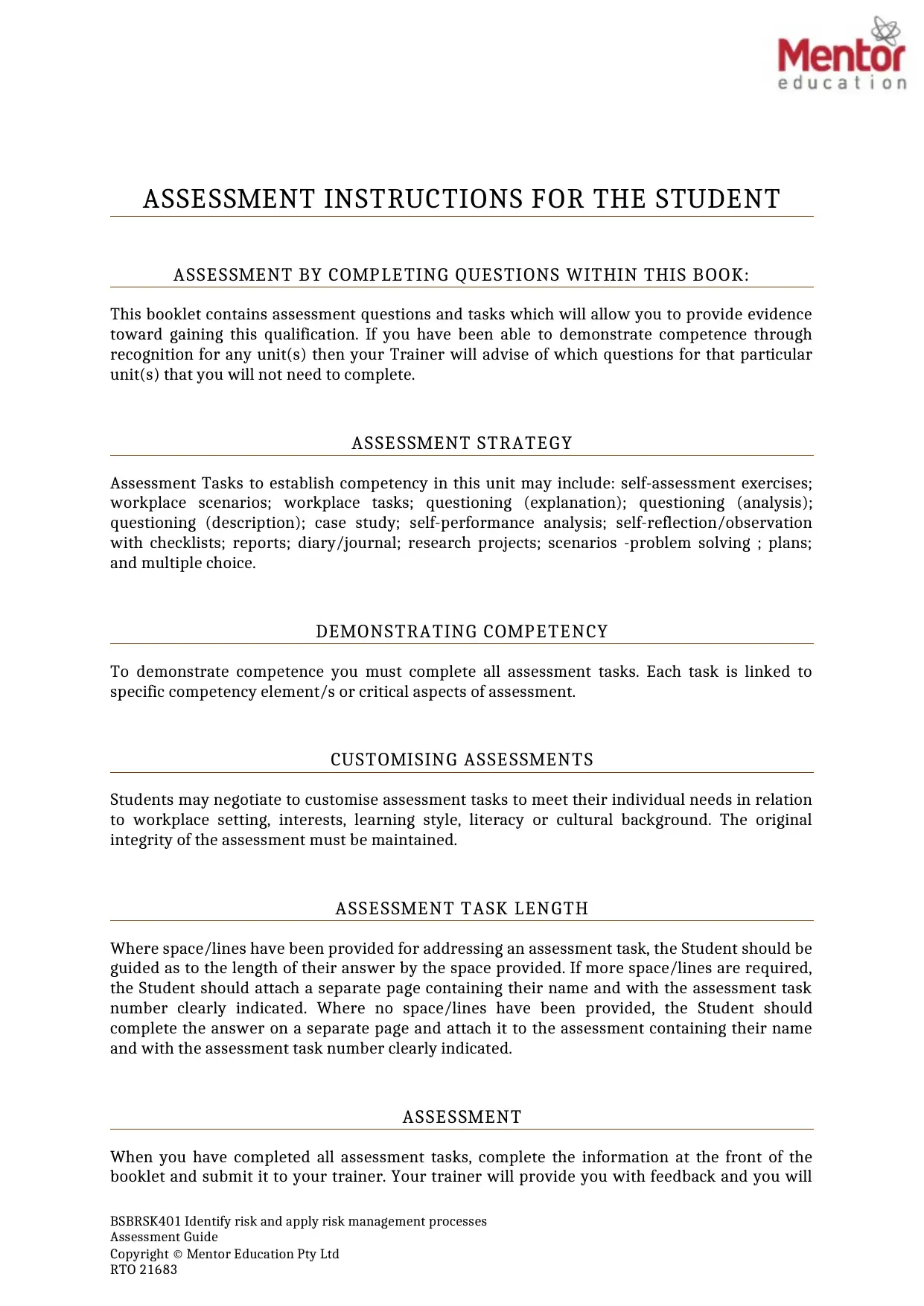
ASSESSMENT INSTRUCTIONS FOR THE STUDENT
ASSESSMENT BY COMPLETING QUESTIONS WITHIN THIS BOOK:
This booklet contains assessment questions and tasks which will allow you to provide evidence
toward gaining this qualification. If you have been able to demonstrate competence through
recognition for any unit(s) then your Trainer will advise of which questions for that particular
unit(s) that you will not need to complete.
ASSESSMENT STRATEGY
Assessment Tasks to establish competency in this unit may include: self-assessment exercises;
workplace scenarios; workplace tasks; questioning (explanation); questioning (analysis);
questioning (description); case study; self-performance analysis; self-reflection/observation
with checklists; reports; diary/journal; research projects; scenarios -problem solving ; plans;
and multiple choice.
DEMONSTRATING COMPETENCY
To demonstrate competence you must complete all assessment tasks. Each task is linked to
specific competency element/s or critical aspects of assessment.
CUSTOMISING ASSESSMENTS
Students may negotiate to customise assessment tasks to meet their individual needs in relation
to workplace setting, interests, learning style, literacy or cultural background. The original
integrity of the assessment must be maintained.
ASSESSMENT TASK LENGTH
Where space/lines have been provided for addressing an assessment task, the Student should be
guided as to the length of their answer by the space provided. If more space/lines are required,
the Student should attach a separate page containing their name and with the assessment task
number clearly indicated. Where no space/lines have been provided, the Student should
complete the answer on a separate page and attach it to the assessment containing their name
and with the assessment task number clearly indicated.
ASSESSMENT
When you have completed all assessment tasks, complete the information at the front of the
booklet and submit it to your trainer. Your trainer will provide you with feedback and you will
BSBRSK401 Identify risk and apply risk management processes
Assessment Guide
Copyright © Mentor Education Pty Ltd
RTO 21683
ASSESSMENT BY COMPLETING QUESTIONS WITHIN THIS BOOK:
This booklet contains assessment questions and tasks which will allow you to provide evidence
toward gaining this qualification. If you have been able to demonstrate competence through
recognition for any unit(s) then your Trainer will advise of which questions for that particular
unit(s) that you will not need to complete.
ASSESSMENT STRATEGY
Assessment Tasks to establish competency in this unit may include: self-assessment exercises;
workplace scenarios; workplace tasks; questioning (explanation); questioning (analysis);
questioning (description); case study; self-performance analysis; self-reflection/observation
with checklists; reports; diary/journal; research projects; scenarios -problem solving ; plans;
and multiple choice.
DEMONSTRATING COMPETENCY
To demonstrate competence you must complete all assessment tasks. Each task is linked to
specific competency element/s or critical aspects of assessment.
CUSTOMISING ASSESSMENTS
Students may negotiate to customise assessment tasks to meet their individual needs in relation
to workplace setting, interests, learning style, literacy or cultural background. The original
integrity of the assessment must be maintained.
ASSESSMENT TASK LENGTH
Where space/lines have been provided for addressing an assessment task, the Student should be
guided as to the length of their answer by the space provided. If more space/lines are required,
the Student should attach a separate page containing their name and with the assessment task
number clearly indicated. Where no space/lines have been provided, the Student should
complete the answer on a separate page and attach it to the assessment containing their name
and with the assessment task number clearly indicated.
ASSESSMENT
When you have completed all assessment tasks, complete the information at the front of the
booklet and submit it to your trainer. Your trainer will provide you with feedback and you will
BSBRSK401 Identify risk and apply risk management processes
Assessment Guide
Copyright © Mentor Education Pty Ltd
RTO 21683
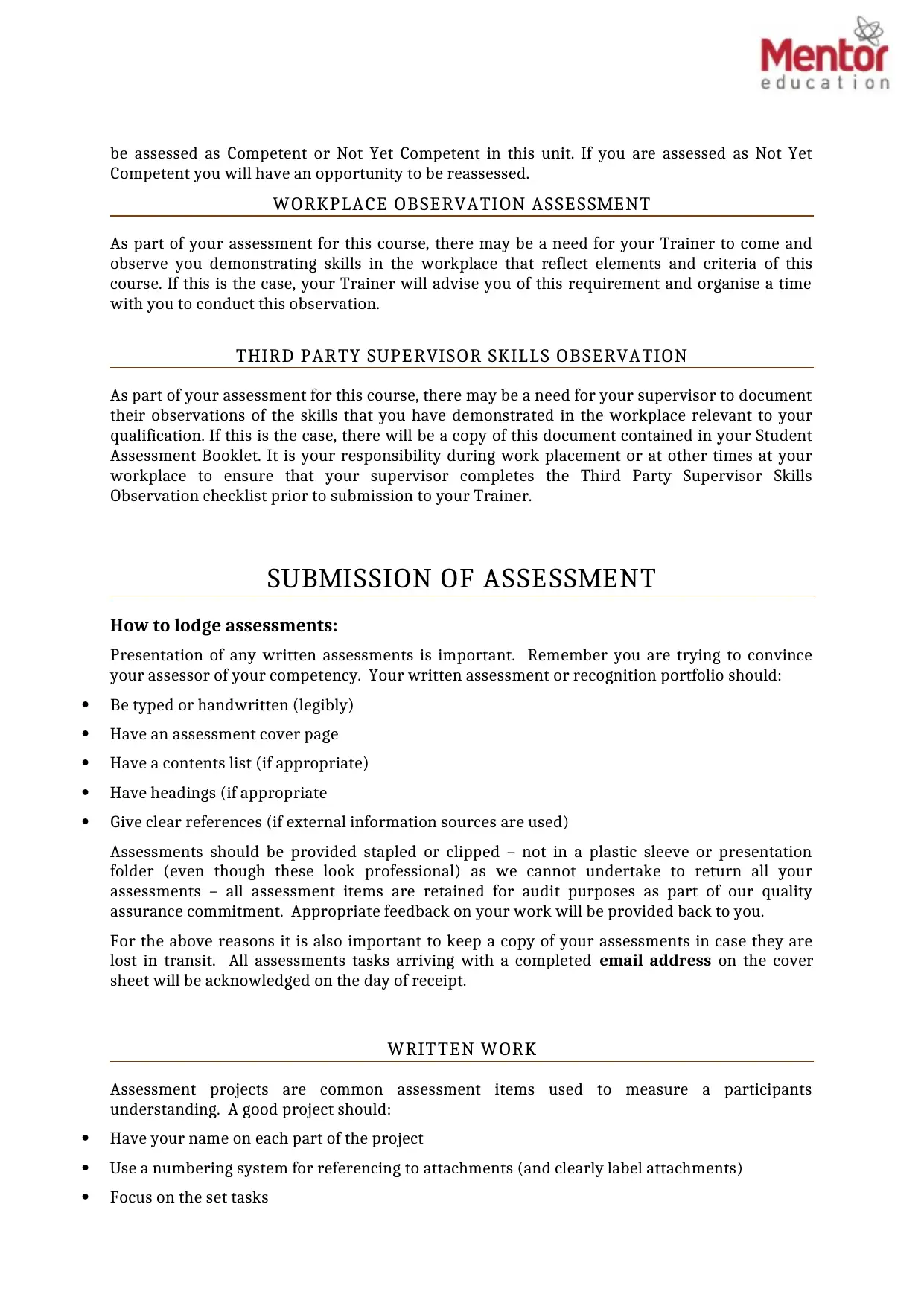
be assessed as Competent or Not Yet Competent in this unit. If you are assessed as Not Yet
Competent you will have an opportunity to be reassessed.
WORKPLACE OBSERVATION ASSESSMENT
As part of your assessment for this course, there may be a need for your Trainer to come and
observe you demonstrating skills in the workplace that reflect elements and criteria of this
course. If this is the case, your Trainer will advise you of this requirement and organise a time
with you to conduct this observation.
THIRD PARTY SUPERVISOR SKILLS OBSERVATION
As part of your assessment for this course, there may be a need for your supervisor to document
their observations of the skills that you have demonstrated in the workplace relevant to your
qualification. If this is the case, there will be a copy of this document contained in your Student
Assessment Booklet. It is your responsibility during work placement or at other times at your
workplace to ensure that your supervisor completes the Third Party Supervisor Skills
Observation checklist prior to submission to your Trainer.
SUBMISSION OF ASSESSMENT
How to lodge assessments:
Presentation of any written assessments is important. Remember you are trying to convince
your assessor of your competency. Your written assessment or recognition portfolio should:
Be typed or handwritten (legibly)
Have an assessment cover page
Have a contents list (if appropriate)
Have headings (if appropriate
Give clear references (if external information sources are used)
Assessments should be provided stapled or clipped – not in a plastic sleeve or presentation
folder (even though these look professional) as we cannot undertake to return all your
assessments – all assessment items are retained for audit purposes as part of our quality
assurance commitment. Appropriate feedback on your work will be provided back to you.
For the above reasons it is also important to keep a copy of your assessments in case they are
lost in transit. All assessments tasks arriving with a completed email address on the cover
sheet will be acknowledged on the day of receipt.
WRITTEN WORK
Assessment projects are common assessment items used to measure a participants
understanding. A good project should:
Have your name on each part of the project
Use a numbering system for referencing to attachments (and clearly label attachments)
Focus on the set tasks
Competent you will have an opportunity to be reassessed.
WORKPLACE OBSERVATION ASSESSMENT
As part of your assessment for this course, there may be a need for your Trainer to come and
observe you demonstrating skills in the workplace that reflect elements and criteria of this
course. If this is the case, your Trainer will advise you of this requirement and organise a time
with you to conduct this observation.
THIRD PARTY SUPERVISOR SKILLS OBSERVATION
As part of your assessment for this course, there may be a need for your supervisor to document
their observations of the skills that you have demonstrated in the workplace relevant to your
qualification. If this is the case, there will be a copy of this document contained in your Student
Assessment Booklet. It is your responsibility during work placement or at other times at your
workplace to ensure that your supervisor completes the Third Party Supervisor Skills
Observation checklist prior to submission to your Trainer.
SUBMISSION OF ASSESSMENT
How to lodge assessments:
Presentation of any written assessments is important. Remember you are trying to convince
your assessor of your competency. Your written assessment or recognition portfolio should:
Be typed or handwritten (legibly)
Have an assessment cover page
Have a contents list (if appropriate)
Have headings (if appropriate
Give clear references (if external information sources are used)
Assessments should be provided stapled or clipped – not in a plastic sleeve or presentation
folder (even though these look professional) as we cannot undertake to return all your
assessments – all assessment items are retained for audit purposes as part of our quality
assurance commitment. Appropriate feedback on your work will be provided back to you.
For the above reasons it is also important to keep a copy of your assessments in case they are
lost in transit. All assessments tasks arriving with a completed email address on the cover
sheet will be acknowledged on the day of receipt.
WRITTEN WORK
Assessment projects are common assessment items used to measure a participants
understanding. A good project should:
Have your name on each part of the project
Use a numbering system for referencing to attachments (and clearly label attachments)
Focus on the set tasks
⊘ This is a preview!⊘
Do you want full access?
Subscribe today to unlock all pages.

Trusted by 1+ million students worldwide
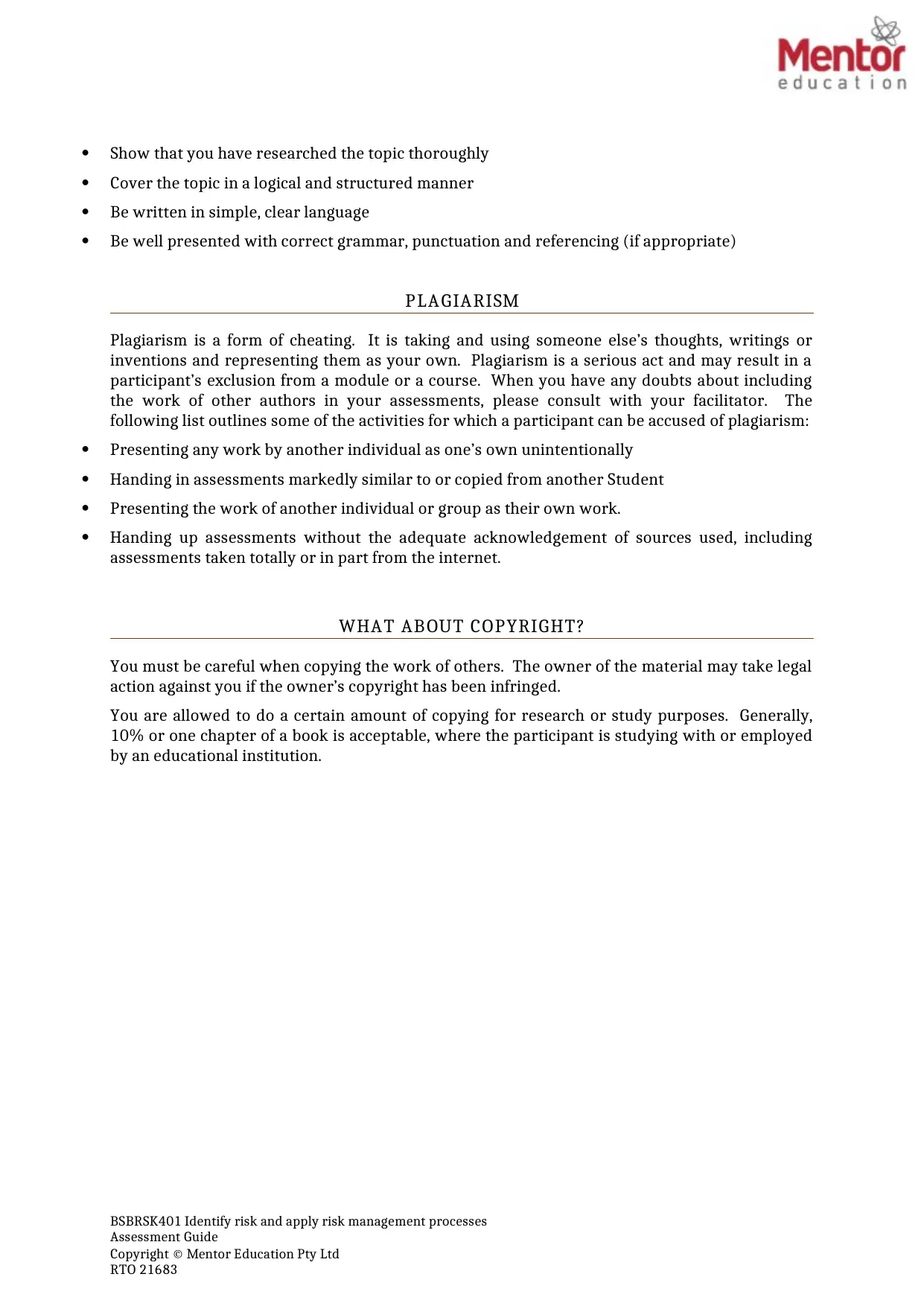
Show that you have researched the topic thoroughly
Cover the topic in a logical and structured manner
Be written in simple, clear language
Be well presented with correct grammar, punctuation and referencing (if appropriate)
PLAGIARISM
Plagiarism is a form of cheating. It is taking and using someone else’s thoughts, writings or
inventions and representing them as your own. Plagiarism is a serious act and may result in a
participant’s exclusion from a module or a course. When you have any doubts about including
the work of other authors in your assessments, please consult with your facilitator. The
following list outlines some of the activities for which a participant can be accused of plagiarism:
Presenting any work by another individual as one’s own unintentionally
Handing in assessments markedly similar to or copied from another Student
Presenting the work of another individual or group as their own work.
Handing up assessments without the adequate acknowledgement of sources used, including
assessments taken totally or in part from the internet.
WHAT ABOUT COPYRIGHT?
You must be careful when copying the work of others. The owner of the material may take legal
action against you if the owner’s copyright has been infringed.
You are allowed to do a certain amount of copying for research or study purposes. Generally,
10% or one chapter of a book is acceptable, where the participant is studying with or employed
by an educational institution.
BSBRSK401 Identify risk and apply risk management processes
Assessment Guide
Copyright © Mentor Education Pty Ltd
RTO 21683
Cover the topic in a logical and structured manner
Be written in simple, clear language
Be well presented with correct grammar, punctuation and referencing (if appropriate)
PLAGIARISM
Plagiarism is a form of cheating. It is taking and using someone else’s thoughts, writings or
inventions and representing them as your own. Plagiarism is a serious act and may result in a
participant’s exclusion from a module or a course. When you have any doubts about including
the work of other authors in your assessments, please consult with your facilitator. The
following list outlines some of the activities for which a participant can be accused of plagiarism:
Presenting any work by another individual as one’s own unintentionally
Handing in assessments markedly similar to or copied from another Student
Presenting the work of another individual or group as their own work.
Handing up assessments without the adequate acknowledgement of sources used, including
assessments taken totally or in part from the internet.
WHAT ABOUT COPYRIGHT?
You must be careful when copying the work of others. The owner of the material may take legal
action against you if the owner’s copyright has been infringed.
You are allowed to do a certain amount of copying for research or study purposes. Generally,
10% or one chapter of a book is acceptable, where the participant is studying with or employed
by an educational institution.
BSBRSK401 Identify risk and apply risk management processes
Assessment Guide
Copyright © Mentor Education Pty Ltd
RTO 21683
Paraphrase This Document
Need a fresh take? Get an instant paraphrase of this document with our AI Paraphraser
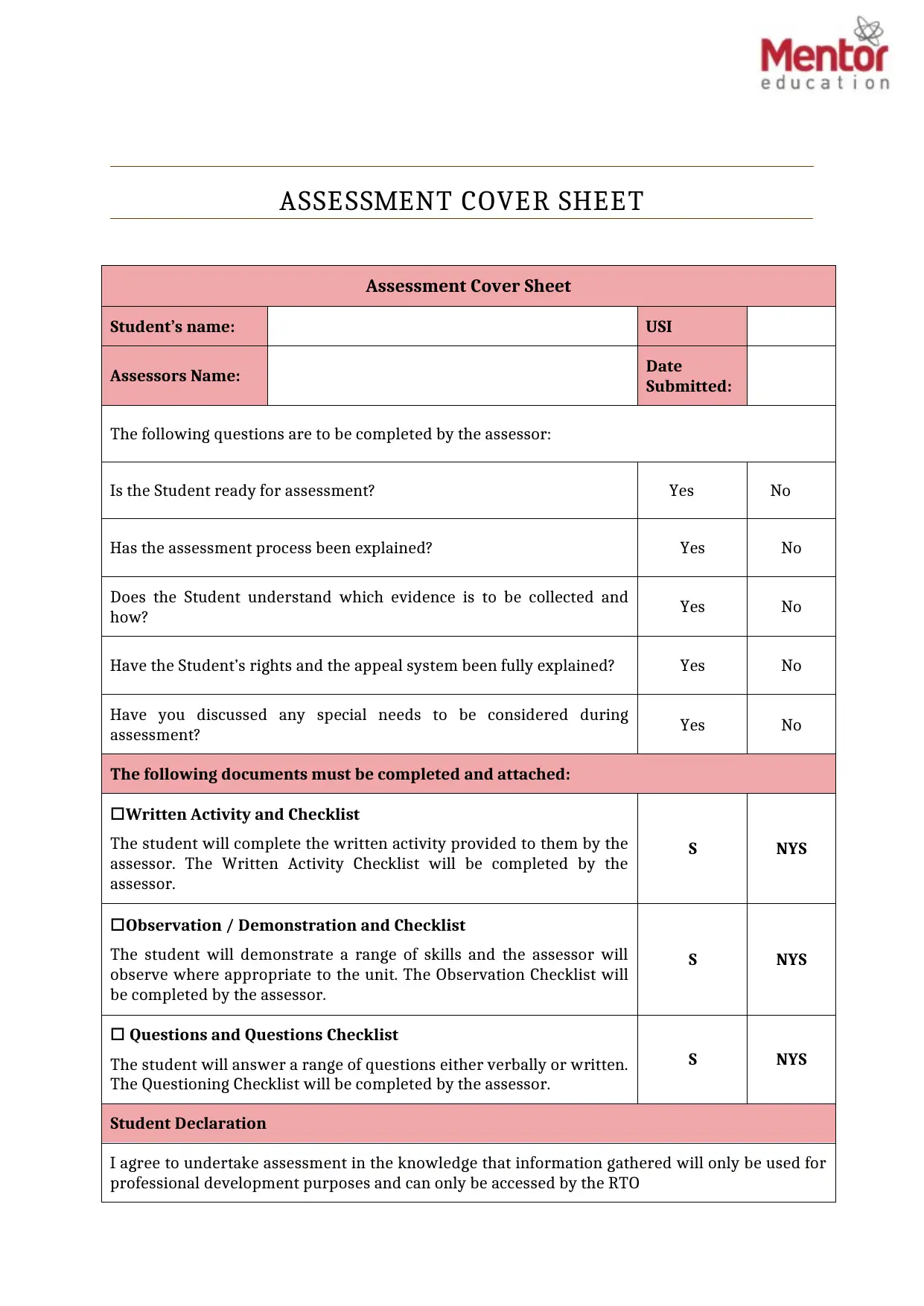
ASSESSMENT COVER SHEET
Assessment Cover Sheet
Student’s name: USI
Assessors Name: Date
Submitted:
The following questions are to be completed by the assessor:
Is the Student ready for assessment? Yes No
Has the assessment process been explained? Yes No
Does the Student understand which evidence is to be collected and
how? Yes No
Have the Student’s rights and the appeal system been fully explained? Yes No
Have you discussed any special needs to be considered during
assessment? Yes No
The following documents must be completed and attached:
Written Activity and Checklist
The student will complete the written activity provided to them by the
assessor. The Written Activity Checklist will be completed by the
assessor.
S NYS
Observation / Demonstration and Checklist
The student will demonstrate a range of skills and the assessor will
observe where appropriate to the unit. The Observation Checklist will
be completed by the assessor.
S NYS
Questions and Questions Checklist
The student will answer a range of questions either verbally or written.
The Questioning Checklist will be completed by the assessor.
S NYS
Student Declaration
I agree to undertake assessment in the knowledge that information gathered will only be used for
professional development purposes and can only be accessed by the RTO
Assessment Cover Sheet
Student’s name: USI
Assessors Name: Date
Submitted:
The following questions are to be completed by the assessor:
Is the Student ready for assessment? Yes No
Has the assessment process been explained? Yes No
Does the Student understand which evidence is to be collected and
how? Yes No
Have the Student’s rights and the appeal system been fully explained? Yes No
Have you discussed any special needs to be considered during
assessment? Yes No
The following documents must be completed and attached:
Written Activity and Checklist
The student will complete the written activity provided to them by the
assessor. The Written Activity Checklist will be completed by the
assessor.
S NYS
Observation / Demonstration and Checklist
The student will demonstrate a range of skills and the assessor will
observe where appropriate to the unit. The Observation Checklist will
be completed by the assessor.
S NYS
Questions and Questions Checklist
The student will answer a range of questions either verbally or written.
The Questioning Checklist will be completed by the assessor.
S NYS
Student Declaration
I agree to undertake assessment in the knowledge that information gathered will only be used for
professional development purposes and can only be accessed by the RTO
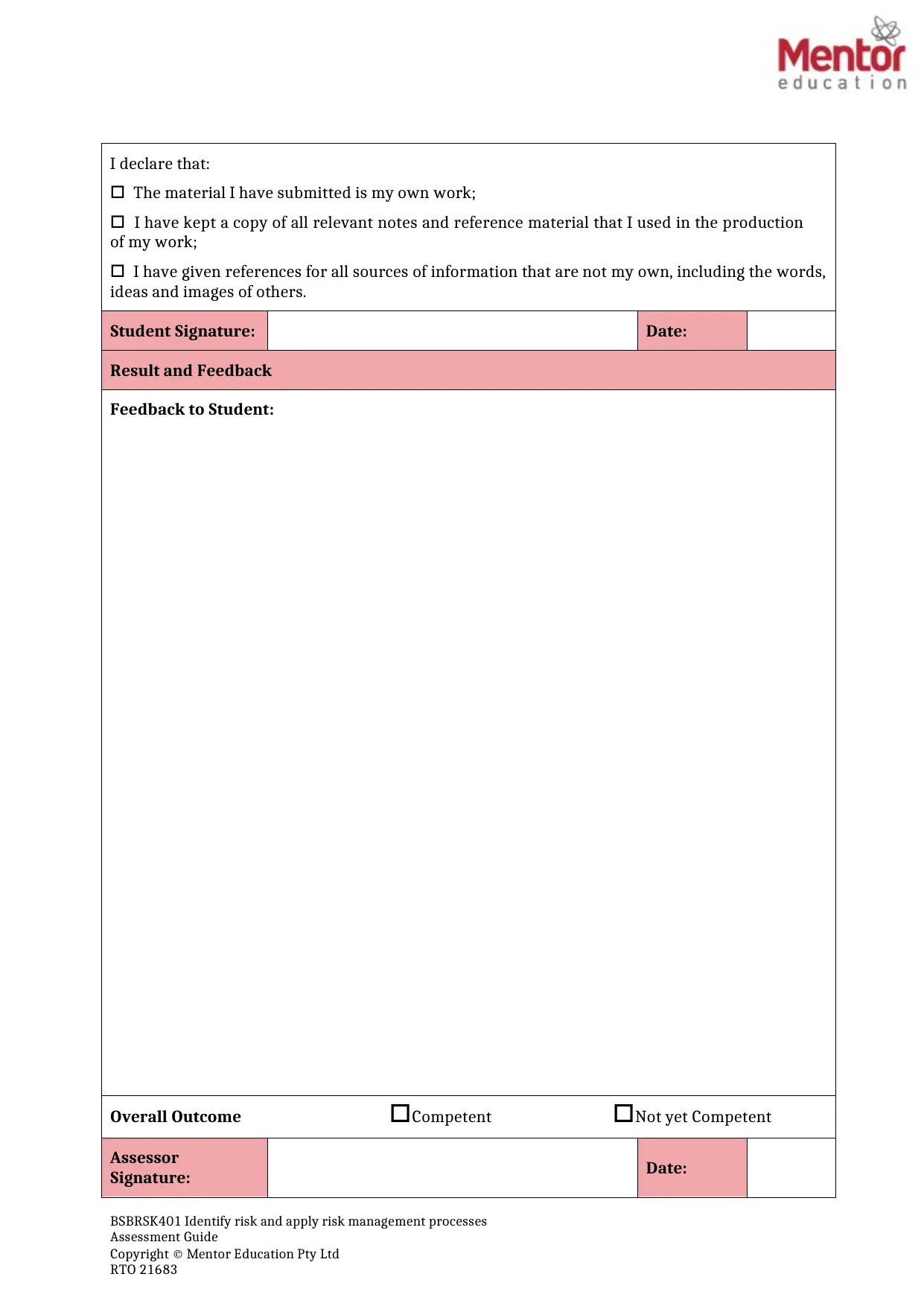
I declare that:
The material I have submitted is my own work;
I have kept a copy of all relevant notes and reference material that I used in the production
of my work;
I have given references for all sources of information that are not my own, including the words,
ideas and images of others.
Student Signature: Date:
Result and Feedback
Feedback to Student:
Overall Outcome Competent Not yet Competent
Assessor
Signature: Date:
BSBRSK401 Identify risk and apply risk management processes
Assessment Guide
Copyright © Mentor Education Pty Ltd
RTO 21683
The material I have submitted is my own work;
I have kept a copy of all relevant notes and reference material that I used in the production
of my work;
I have given references for all sources of information that are not my own, including the words,
ideas and images of others.
Student Signature: Date:
Result and Feedback
Feedback to Student:
Overall Outcome Competent Not yet Competent
Assessor
Signature: Date:
BSBRSK401 Identify risk and apply risk management processes
Assessment Guide
Copyright © Mentor Education Pty Ltd
RTO 21683
⊘ This is a preview!⊘
Do you want full access?
Subscribe today to unlock all pages.

Trusted by 1+ million students worldwide
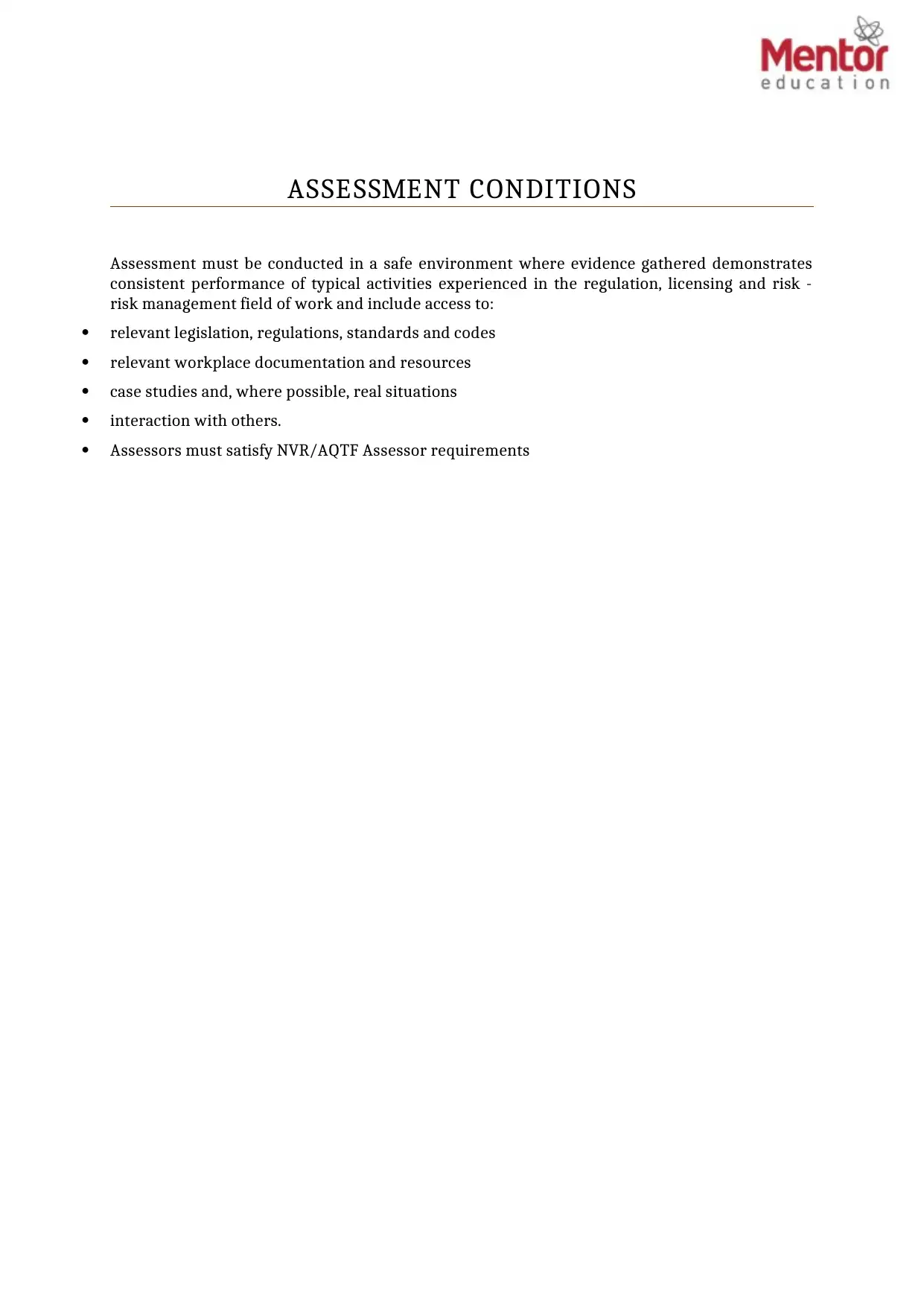
ASSESSMENT CONDITIONS
Assessment must be conducted in a safe environment where evidence gathered demonstrates
consistent performance of typical activities experienced in the regulation, licensing and risk -
risk management field of work and include access to:
relevant legislation, regulations, standards and codes
relevant workplace documentation and resources
case studies and, where possible, real situations
interaction with others.
Assessors must satisfy NVR/AQTF Assessor requirements
Assessment must be conducted in a safe environment where evidence gathered demonstrates
consistent performance of typical activities experienced in the regulation, licensing and risk -
risk management field of work and include access to:
relevant legislation, regulations, standards and codes
relevant workplace documentation and resources
case studies and, where possible, real situations
interaction with others.
Assessors must satisfy NVR/AQTF Assessor requirements
Paraphrase This Document
Need a fresh take? Get an instant paraphrase of this document with our AI Paraphraser
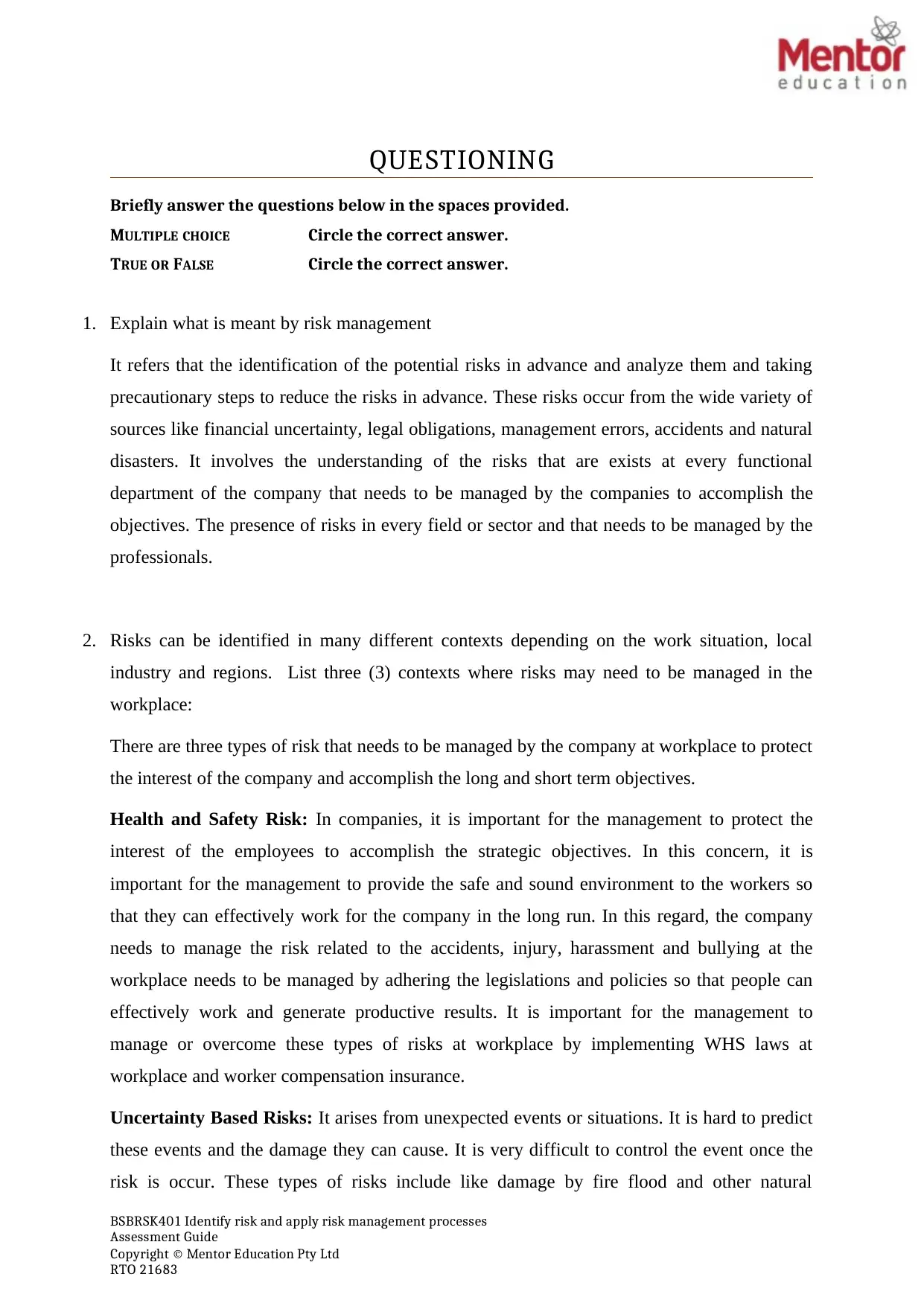
QUESTIONING
Briefly answer the questions below in the spaces provided.
MULTIPLE CHOICE Circle the correct answer.
TRUE OR FALSE Circle the correct answer.
1. Explain what is meant by risk management
It refers that the identification of the potential risks in advance and analyze them and taking
precautionary steps to reduce the risks in advance. These risks occur from the wide variety of
sources like financial uncertainty, legal obligations, management errors, accidents and natural
disasters. It involves the understanding of the risks that are exists at every functional
department of the company that needs to be managed by the companies to accomplish the
objectives. The presence of risks in every field or sector and that needs to be managed by the
professionals.
2. Risks can be identified in many different contexts depending on the work situation, local
industry and regions. List three (3) contexts where risks may need to be managed in the
workplace:
There are three types of risk that needs to be managed by the company at workplace to protect
the interest of the company and accomplish the long and short term objectives.
Health and Safety Risk: In companies, it is important for the management to protect the
interest of the employees to accomplish the strategic objectives. In this concern, it is
important for the management to provide the safe and sound environment to the workers so
that they can effectively work for the company in the long run. In this regard, the company
needs to manage the risk related to the accidents, injury, harassment and bullying at the
workplace needs to be managed by adhering the legislations and policies so that people can
effectively work and generate productive results. It is important for the management to
manage or overcome these types of risks at workplace by implementing WHS laws at
workplace and worker compensation insurance.
Uncertainty Based Risks: It arises from unexpected events or situations. It is hard to predict
these events and the damage they can cause. It is very difficult to control the event once the
risk is occur. These types of risks include like damage by fire flood and other natural
BSBRSK401 Identify risk and apply risk management processes
Assessment Guide
Copyright © Mentor Education Pty Ltd
RTO 21683
Briefly answer the questions below in the spaces provided.
MULTIPLE CHOICE Circle the correct answer.
TRUE OR FALSE Circle the correct answer.
1. Explain what is meant by risk management
It refers that the identification of the potential risks in advance and analyze them and taking
precautionary steps to reduce the risks in advance. These risks occur from the wide variety of
sources like financial uncertainty, legal obligations, management errors, accidents and natural
disasters. It involves the understanding of the risks that are exists at every functional
department of the company that needs to be managed by the companies to accomplish the
objectives. The presence of risks in every field or sector and that needs to be managed by the
professionals.
2. Risks can be identified in many different contexts depending on the work situation, local
industry and regions. List three (3) contexts where risks may need to be managed in the
workplace:
There are three types of risk that needs to be managed by the company at workplace to protect
the interest of the company and accomplish the long and short term objectives.
Health and Safety Risk: In companies, it is important for the management to protect the
interest of the employees to accomplish the strategic objectives. In this concern, it is
important for the management to provide the safe and sound environment to the workers so
that they can effectively work for the company in the long run. In this regard, the company
needs to manage the risk related to the accidents, injury, harassment and bullying at the
workplace needs to be managed by adhering the legislations and policies so that people can
effectively work and generate productive results. It is important for the management to
manage or overcome these types of risks at workplace by implementing WHS laws at
workplace and worker compensation insurance.
Uncertainty Based Risks: It arises from unexpected events or situations. It is hard to predict
these events and the damage they can cause. It is very difficult to control the event once the
risk is occur. These types of risks include like damage by fire flood and other natural
BSBRSK401 Identify risk and apply risk management processes
Assessment Guide
Copyright © Mentor Education Pty Ltd
RTO 21683
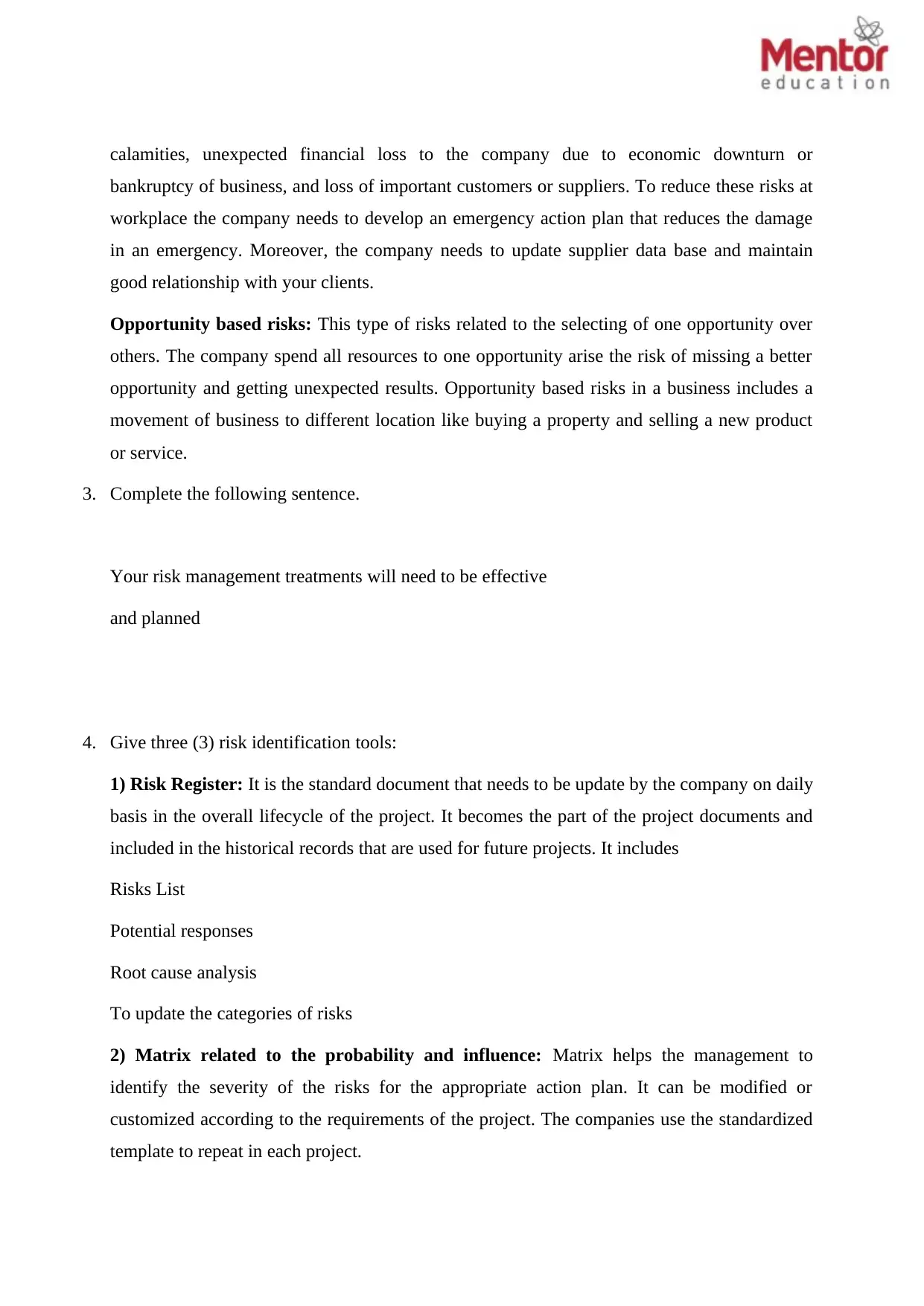
calamities, unexpected financial loss to the company due to economic downturn or
bankruptcy of business, and loss of important customers or suppliers. To reduce these risks at
workplace the company needs to develop an emergency action plan that reduces the damage
in an emergency. Moreover, the company needs to update supplier data base and maintain
good relationship with your clients.
Opportunity based risks: This type of risks related to the selecting of one opportunity over
others. The company spend all resources to one opportunity arise the risk of missing a better
opportunity and getting unexpected results. Opportunity based risks in a business includes a
movement of business to different location like buying a property and selling a new product
or service.
3. Complete the following sentence.
Your risk management treatments will need to be effective
and planned
4. Give three (3) risk identification tools:
1) Risk Register: It is the standard document that needs to be update by the company on daily
basis in the overall lifecycle of the project. It becomes the part of the project documents and
included in the historical records that are used for future projects. It includes
Risks List
Potential responses
Root cause analysis
To update the categories of risks
2) Matrix related to the probability and influence: Matrix helps the management to
identify the severity of the risks for the appropriate action plan. It can be modified or
customized according to the requirements of the project. The companies use the standardized
template to repeat in each project.
bankruptcy of business, and loss of important customers or suppliers. To reduce these risks at
workplace the company needs to develop an emergency action plan that reduces the damage
in an emergency. Moreover, the company needs to update supplier data base and maintain
good relationship with your clients.
Opportunity based risks: This type of risks related to the selecting of one opportunity over
others. The company spend all resources to one opportunity arise the risk of missing a better
opportunity and getting unexpected results. Opportunity based risks in a business includes a
movement of business to different location like buying a property and selling a new product
or service.
3. Complete the following sentence.
Your risk management treatments will need to be effective
and planned
4. Give three (3) risk identification tools:
1) Risk Register: It is the standard document that needs to be update by the company on daily
basis in the overall lifecycle of the project. It becomes the part of the project documents and
included in the historical records that are used for future projects. It includes
Risks List
Potential responses
Root cause analysis
To update the categories of risks
2) Matrix related to the probability and influence: Matrix helps the management to
identify the severity of the risks for the appropriate action plan. It can be modified or
customized according to the requirements of the project. The companies use the standardized
template to repeat in each project.
⊘ This is a preview!⊘
Do you want full access?
Subscribe today to unlock all pages.

Trusted by 1+ million students worldwide
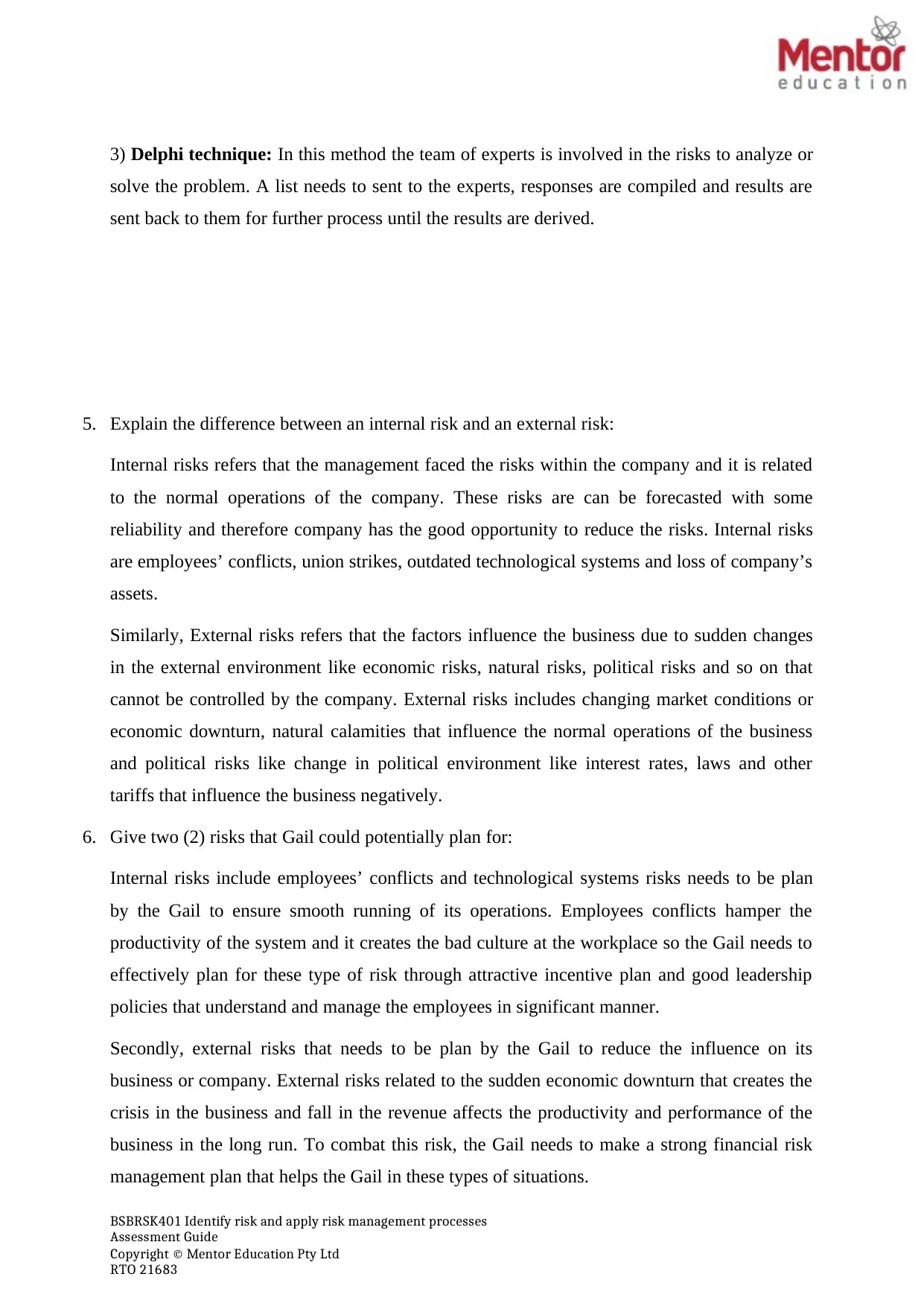
3) Delphi technique: In this method the team of experts is involved in the risks to analyze or
solve the problem. A list needs to sent to the experts, responses are compiled and results are
sent back to them for further process until the results are derived.
5. Explain the difference between an internal risk and an external risk:
Internal risks refers that the management faced the risks within the company and it is related
to the normal operations of the company. These risks are can be forecasted with some
reliability and therefore company has the good opportunity to reduce the risks. Internal risks
are employees’ conflicts, union strikes, outdated technological systems and loss of company’s
assets.
Similarly, External risks refers that the factors influence the business due to sudden changes
in the external environment like economic risks, natural risks, political risks and so on that
cannot be controlled by the company. External risks includes changing market conditions or
economic downturn, natural calamities that influence the normal operations of the business
and political risks like change in political environment like interest rates, laws and other
tariffs that influence the business negatively.
6. Give two (2) risks that Gail could potentially plan for:
Internal risks include employees’ conflicts and technological systems risks needs to be plan
by the Gail to ensure smooth running of its operations. Employees conflicts hamper the
productivity of the system and it creates the bad culture at the workplace so the Gail needs to
effectively plan for these type of risk through attractive incentive plan and good leadership
policies that understand and manage the employees in significant manner.
Secondly, external risks that needs to be plan by the Gail to reduce the influence on its
business or company. External risks related to the sudden economic downturn that creates the
crisis in the business and fall in the revenue affects the productivity and performance of the
business in the long run. To combat this risk, the Gail needs to make a strong financial risk
management plan that helps the Gail in these types of situations.
BSBRSK401 Identify risk and apply risk management processes
Assessment Guide
Copyright © Mentor Education Pty Ltd
RTO 21683
solve the problem. A list needs to sent to the experts, responses are compiled and results are
sent back to them for further process until the results are derived.
5. Explain the difference between an internal risk and an external risk:
Internal risks refers that the management faced the risks within the company and it is related
to the normal operations of the company. These risks are can be forecasted with some
reliability and therefore company has the good opportunity to reduce the risks. Internal risks
are employees’ conflicts, union strikes, outdated technological systems and loss of company’s
assets.
Similarly, External risks refers that the factors influence the business due to sudden changes
in the external environment like economic risks, natural risks, political risks and so on that
cannot be controlled by the company. External risks includes changing market conditions or
economic downturn, natural calamities that influence the normal operations of the business
and political risks like change in political environment like interest rates, laws and other
tariffs that influence the business negatively.
6. Give two (2) risks that Gail could potentially plan for:
Internal risks include employees’ conflicts and technological systems risks needs to be plan
by the Gail to ensure smooth running of its operations. Employees conflicts hamper the
productivity of the system and it creates the bad culture at the workplace so the Gail needs to
effectively plan for these type of risk through attractive incentive plan and good leadership
policies that understand and manage the employees in significant manner.
Secondly, external risks that needs to be plan by the Gail to reduce the influence on its
business or company. External risks related to the sudden economic downturn that creates the
crisis in the business and fall in the revenue affects the productivity and performance of the
business in the long run. To combat this risk, the Gail needs to make a strong financial risk
management plan that helps the Gail in these types of situations.
BSBRSK401 Identify risk and apply risk management processes
Assessment Guide
Copyright © Mentor Education Pty Ltd
RTO 21683
Paraphrase This Document
Need a fresh take? Get an instant paraphrase of this document with our AI Paraphraser
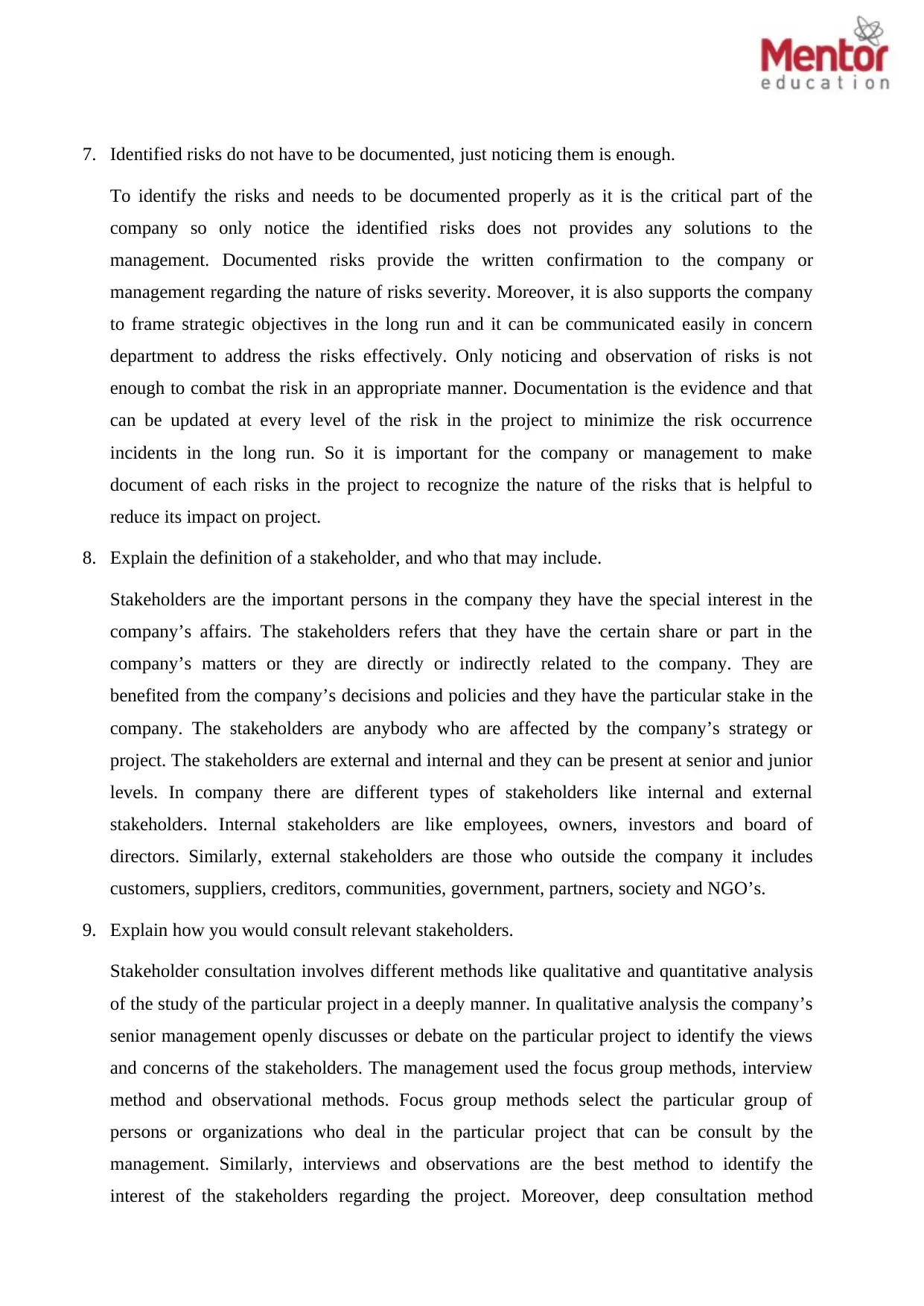
7. Identified risks do not have to be documented, just noticing them is enough.
To identify the risks and needs to be documented properly as it is the critical part of the
company so only notice the identified risks does not provides any solutions to the
management. Documented risks provide the written confirmation to the company or
management regarding the nature of risks severity. Moreover, it is also supports the company
to frame strategic objectives in the long run and it can be communicated easily in concern
department to address the risks effectively. Only noticing and observation of risks is not
enough to combat the risk in an appropriate manner. Documentation is the evidence and that
can be updated at every level of the risk in the project to minimize the risk occurrence
incidents in the long run. So it is important for the company or management to make
document of each risks in the project to recognize the nature of the risks that is helpful to
reduce its impact on project.
8. Explain the definition of a stakeholder, and who that may include.
Stakeholders are the important persons in the company they have the special interest in the
company’s affairs. The stakeholders refers that they have the certain share or part in the
company’s matters or they are directly or indirectly related to the company. They are
benefited from the company’s decisions and policies and they have the particular stake in the
company. The stakeholders are anybody who are affected by the company’s strategy or
project. The stakeholders are external and internal and they can be present at senior and junior
levels. In company there are different types of stakeholders like internal and external
stakeholders. Internal stakeholders are like employees, owners, investors and board of
directors. Similarly, external stakeholders are those who outside the company it includes
customers, suppliers, creditors, communities, government, partners, society and NGO’s.
9. Explain how you would consult relevant stakeholders.
Stakeholder consultation involves different methods like qualitative and quantitative analysis
of the study of the particular project in a deeply manner. In qualitative analysis the company’s
senior management openly discusses or debate on the particular project to identify the views
and concerns of the stakeholders. The management used the focus group methods, interview
method and observational methods. Focus group methods select the particular group of
persons or organizations who deal in the particular project that can be consult by the
management. Similarly, interviews and observations are the best method to identify the
interest of the stakeholders regarding the project. Moreover, deep consultation method
To identify the risks and needs to be documented properly as it is the critical part of the
company so only notice the identified risks does not provides any solutions to the
management. Documented risks provide the written confirmation to the company or
management regarding the nature of risks severity. Moreover, it is also supports the company
to frame strategic objectives in the long run and it can be communicated easily in concern
department to address the risks effectively. Only noticing and observation of risks is not
enough to combat the risk in an appropriate manner. Documentation is the evidence and that
can be updated at every level of the risk in the project to minimize the risk occurrence
incidents in the long run. So it is important for the company or management to make
document of each risks in the project to recognize the nature of the risks that is helpful to
reduce its impact on project.
8. Explain the definition of a stakeholder, and who that may include.
Stakeholders are the important persons in the company they have the special interest in the
company’s affairs. The stakeholders refers that they have the certain share or part in the
company’s matters or they are directly or indirectly related to the company. They are
benefited from the company’s decisions and policies and they have the particular stake in the
company. The stakeholders are anybody who are affected by the company’s strategy or
project. The stakeholders are external and internal and they can be present at senior and junior
levels. In company there are different types of stakeholders like internal and external
stakeholders. Internal stakeholders are like employees, owners, investors and board of
directors. Similarly, external stakeholders are those who outside the company it includes
customers, suppliers, creditors, communities, government, partners, society and NGO’s.
9. Explain how you would consult relevant stakeholders.
Stakeholder consultation involves different methods like qualitative and quantitative analysis
of the study of the particular project in a deeply manner. In qualitative analysis the company’s
senior management openly discusses or debate on the particular project to identify the views
and concerns of the stakeholders. The management used the focus group methods, interview
method and observational methods. Focus group methods select the particular group of
persons or organizations who deal in the particular project that can be consult by the
management. Similarly, interviews and observations are the best method to identify the
interest of the stakeholders regarding the project. Moreover, deep consultation method
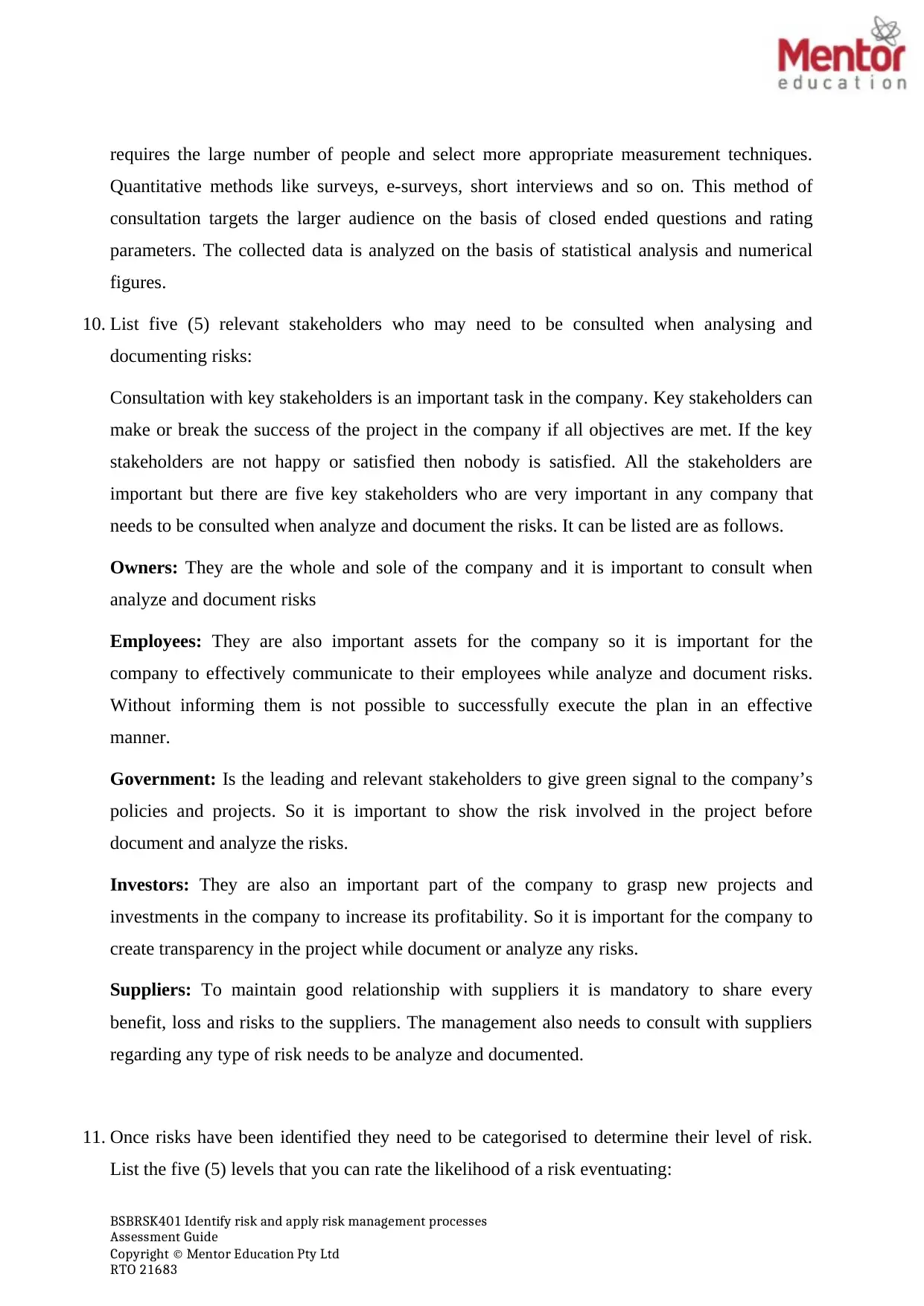
requires the large number of people and select more appropriate measurement techniques.
Quantitative methods like surveys, e-surveys, short interviews and so on. This method of
consultation targets the larger audience on the basis of closed ended questions and rating
parameters. The collected data is analyzed on the basis of statistical analysis and numerical
figures.
10. List five (5) relevant stakeholders who may need to be consulted when analysing and
documenting risks:
Consultation with key stakeholders is an important task in the company. Key stakeholders can
make or break the success of the project in the company if all objectives are met. If the key
stakeholders are not happy or satisfied then nobody is satisfied. All the stakeholders are
important but there are five key stakeholders who are very important in any company that
needs to be consulted when analyze and document the risks. It can be listed are as follows.
Owners: They are the whole and sole of the company and it is important to consult when
analyze and document risks
Employees: They are also important assets for the company so it is important for the
company to effectively communicate to their employees while analyze and document risks.
Without informing them is not possible to successfully execute the plan in an effective
manner.
Government: Is the leading and relevant stakeholders to give green signal to the company’s
policies and projects. So it is important to show the risk involved in the project before
document and analyze the risks.
Investors: They are also an important part of the company to grasp new projects and
investments in the company to increase its profitability. So it is important for the company to
create transparency in the project while document or analyze any risks.
Suppliers: To maintain good relationship with suppliers it is mandatory to share every
benefit, loss and risks to the suppliers. The management also needs to consult with suppliers
regarding any type of risk needs to be analyze and documented.
11. Once risks have been identified they need to be categorised to determine their level of risk.
List the five (5) levels that you can rate the likelihood of a risk eventuating:
BSBRSK401 Identify risk and apply risk management processes
Assessment Guide
Copyright © Mentor Education Pty Ltd
RTO 21683
Quantitative methods like surveys, e-surveys, short interviews and so on. This method of
consultation targets the larger audience on the basis of closed ended questions and rating
parameters. The collected data is analyzed on the basis of statistical analysis and numerical
figures.
10. List five (5) relevant stakeholders who may need to be consulted when analysing and
documenting risks:
Consultation with key stakeholders is an important task in the company. Key stakeholders can
make or break the success of the project in the company if all objectives are met. If the key
stakeholders are not happy or satisfied then nobody is satisfied. All the stakeholders are
important but there are five key stakeholders who are very important in any company that
needs to be consulted when analyze and document the risks. It can be listed are as follows.
Owners: They are the whole and sole of the company and it is important to consult when
analyze and document risks
Employees: They are also important assets for the company so it is important for the
company to effectively communicate to their employees while analyze and document risks.
Without informing them is not possible to successfully execute the plan in an effective
manner.
Government: Is the leading and relevant stakeholders to give green signal to the company’s
policies and projects. So it is important to show the risk involved in the project before
document and analyze the risks.
Investors: They are also an important part of the company to grasp new projects and
investments in the company to increase its profitability. So it is important for the company to
create transparency in the project while document or analyze any risks.
Suppliers: To maintain good relationship with suppliers it is mandatory to share every
benefit, loss and risks to the suppliers. The management also needs to consult with suppliers
regarding any type of risk needs to be analyze and documented.
11. Once risks have been identified they need to be categorised to determine their level of risk.
List the five (5) levels that you can rate the likelihood of a risk eventuating:
BSBRSK401 Identify risk and apply risk management processes
Assessment Guide
Copyright © Mentor Education Pty Ltd
RTO 21683
⊘ This is a preview!⊘
Do you want full access?
Subscribe today to unlock all pages.

Trusted by 1+ million students worldwide
1 out of 32
Related Documents
Your All-in-One AI-Powered Toolkit for Academic Success.
+13062052269
info@desklib.com
Available 24*7 on WhatsApp / Email
![[object Object]](/_next/static/media/star-bottom.7253800d.svg)
Unlock your academic potential
Copyright © 2020–2025 A2Z Services. All Rights Reserved. Developed and managed by ZUCOL.





